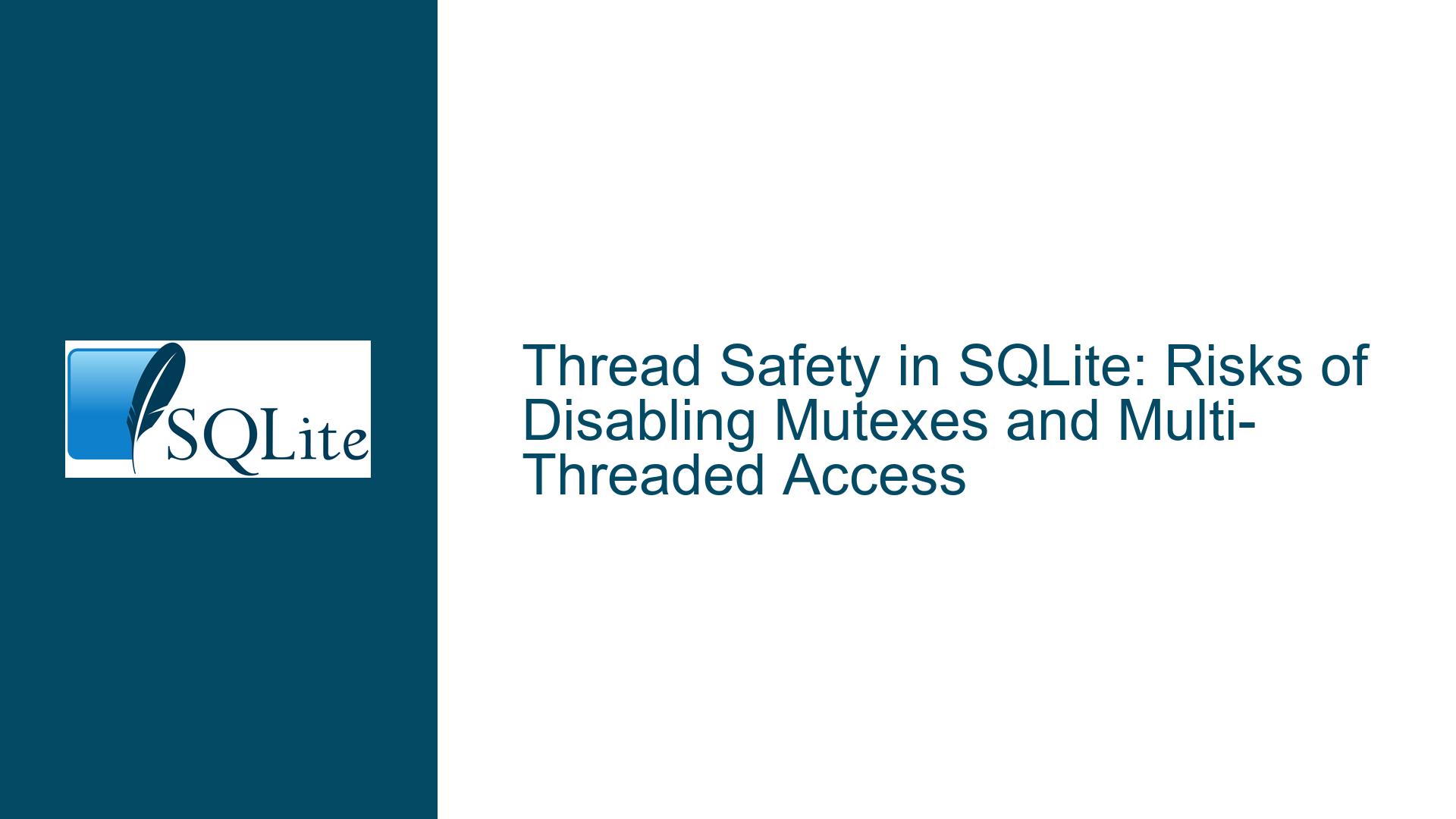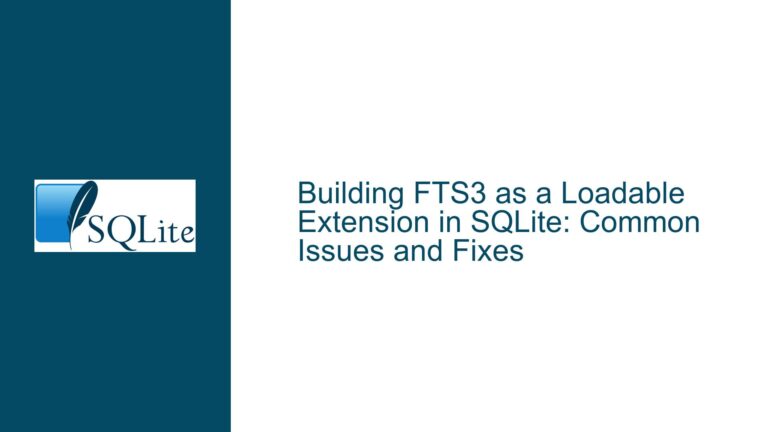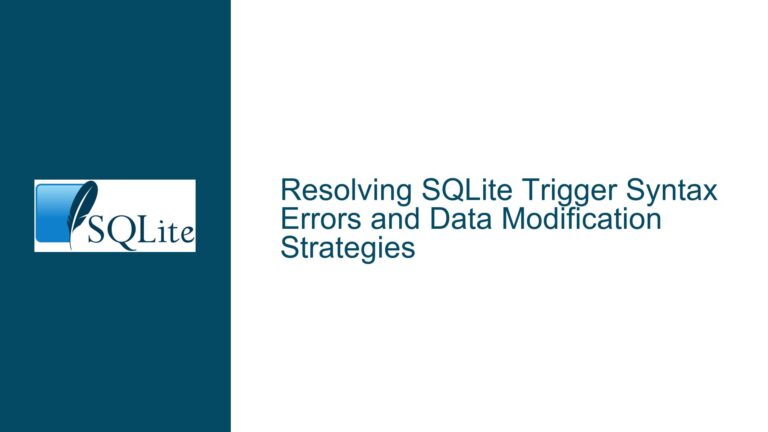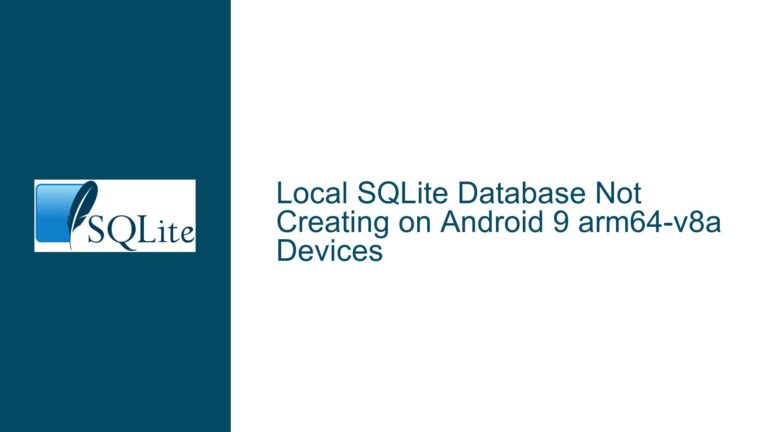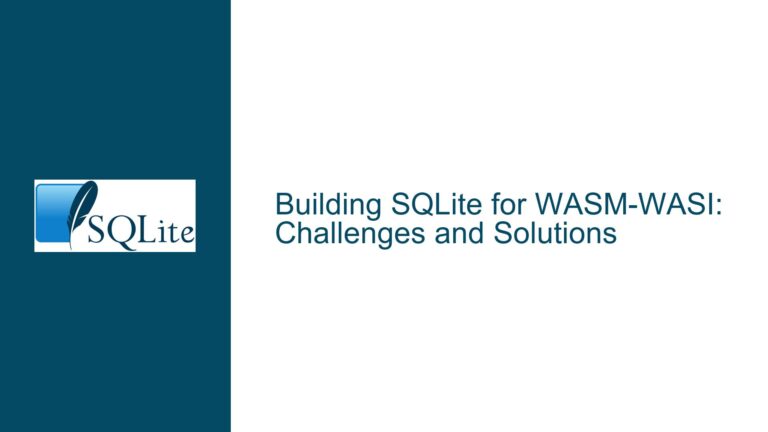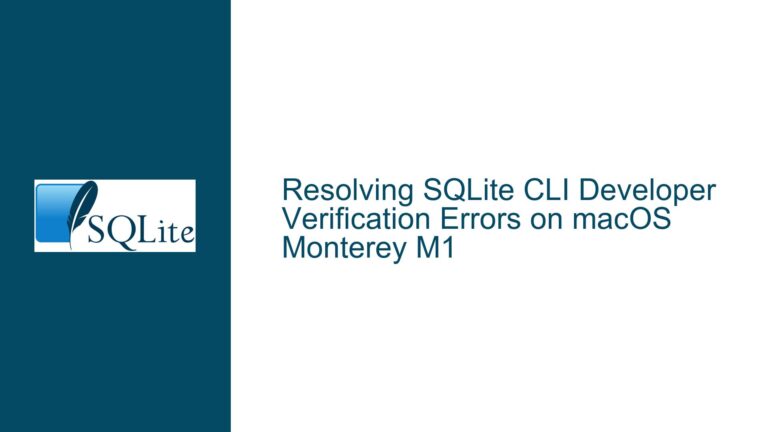Thread Safety in SQLite: Risks of Disabling Mutexes and Multi-Threaded Access
Understanding the Risks of Disabling SQLite Thread Safety
SQLite is a powerful, lightweight database engine that supports various threading modes, including single-threaded, multi-threaded, and serialized modes. The thread safety of SQLite is controlled by compile-time options and runtime configurations. Disabling thread safety by compiling SQLite without mutexes (SQLITE_THREADSAFE=0) is a dangerous practice when multiple threads are involved, even if those threads operate on separate database connections or in-memory databases. This approach can lead to undefined behavior, data corruption, and crashes due to the lack of synchronization mechanisms within the SQLite library itself.
When SQLite is compiled in single-thread mode, it assumes that only one thread will ever access the library at any given time. This assumption allows SQLite to skip the overhead of mutexes and other synchronization primitives, which can improve performance in single-threaded applications. However, this optimization comes at a significant cost: the library becomes unsafe for concurrent use, even if the threads are operating on entirely separate databases or virtual file systems (VFS). The reason for this is that SQLite relies on certain global state and shared resources internally, such as memory allocators, static variables, and internal data structures. Without proper synchronization, concurrent access to these resources can lead to race conditions, memory corruption, and unpredictable behavior.
The original poster’s use case involves creating multiple connections, each with its own in-memory database using a custom memory VFS (memvfs). While this setup might seem safe at first glance—since each thread operates on its own database and no shared state is explicitly used—it still violates the fundamental requirement of single-thread mode: only one thread may access the SQLite library at any time. This restriction applies regardless of whether the threads are accessing the same database or different databases. The lack of mutexes means that concurrent calls to SQLite functions, even from different threads operating on separate connections, can interfere with each other and cause the library to malfunction.
Why Separate Connections and Custom VFS Do Not Guarantee Safety
The misconception that separate connections and custom VFS implementations can ensure thread safety in single-thread mode stems from a misunderstanding of how SQLite manages its internal state. While it is true that each SQLite connection is independent and can operate on its own database, the SQLite library itself is not entirely stateless. Certain operations, such as memory allocation, error handling, and initialization of global data structures, are shared across all connections within a process. These operations are not thread-safe when SQLite is compiled without mutexes.
For example, consider the memory allocator used by SQLite. In single-thread mode, the allocator assumes that no other thread will concurrently allocate or free memory. If multiple threads attempt to allocate memory at the same time, the allocator’s internal state can become corrupted, leading to crashes or memory leaks. Similarly, SQLite’s error handling mechanism relies on global variables to store the most recent error code and message. Concurrent access to these variables by multiple threads can result in incorrect or inconsistent error reporting.
The use of a custom memory VFS (memvfs) does not mitigate these risks. While the memvfs implementation may be thread-safe and ensure that each thread operates on its own set of memory pages, it does not address the thread safety issues within the SQLite library itself. The SQLite library still performs operations that are not safe for concurrent execution, such as initializing data structures, managing internal caches, and handling transactions. These operations can interfere with each other when performed by multiple threads, even if the threads are using separate connections and VFS implementations.
Furthermore, the original poster’s design involves creating a new SQLite instance in the main thread and passing a reference to the memvfs object to worker threads for read-only queries. This approach introduces additional risks, as the main thread and worker threads may concurrently access the SQLite library. For example, the main thread might call sqlite3_open() to create a new connection while a worker thread is executing a query using an existing connection. In single-thread mode, these concurrent operations are not safe and can lead to undefined behavior.
Best Practices for Thread-Safe SQLite Usage in Multi-Threaded Applications
To ensure thread safety in a multi-threaded application, SQLite should always be compiled with mutexes enabled (SQLITE_THREADSAFE=1 or SQLITE_THREADSAFE=2). This ensures that the library can safely handle concurrent access from multiple threads, even if those threads are operating on separate connections or databases. The performance overhead of mutexes is generally minimal and is outweighed by the benefits of thread safety and data integrity.
If the goal is to avoid locks in the main thread’s event loop, consider the following alternative approaches:
Use a Dedicated Writer Thread: Move all write operations to a dedicated writer thread, while allowing the main thread and worker threads to perform read-only queries. This approach eliminates the need for locks in the main thread and allows SQLite to operate in standard multi-thread mode. The writer thread can handle all database modifications, including checkpoints and WAL (Write-Ahead Logging) operations, while the main thread and worker threads perform read-only queries using separate connections.
Leverage Connection Pooling: Use a connection pool to manage database connections and ensure that each thread has its own connection for read-only queries. Connection pooling can reduce the overhead of creating and destroying connections, while also ensuring that each thread operates on its own connection. This approach works well in multi-thread mode, where each connection is independent and thread-safe.
Optimize Transaction Semantics: Ensure that all write transactions are short and use the
BEGIN IMMEDIATEorBEGIN EXCLUSIVEmodes to avoid deadlocks. These modes prevent other threads from acquiring conflicting locks and ensure that write transactions can proceed without blocking. For read-only queries, use theBEGIN DEFERREDmode to avoid unnecessary locks and improve concurrency.Consider Alternative Solutions: If the use case requires extreme performance and low-latency access to the database, consider alternative solutions such as embedding SQLite in a WebAssembly (WASM) VM or using a different database engine that is designed for high-concurrency workloads. However, these solutions come with their own trade-offs and should be carefully evaluated based on the specific requirements of the application.
In conclusion, disabling thread safety in SQLite is not a viable solution for multi-threaded applications, even if each thread operates on its own database or VFS. The risks of data corruption, crashes, and undefined behavior far outweigh the potential performance benefits. By following best practices for thread-safe SQLite usage, developers can ensure the reliability and integrity of their applications while maintaining high performance and scalability.
